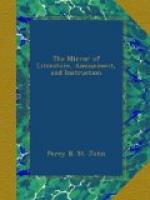“I put some farther questions to him, and found that his title was legitimate. His family had lived in the fortress from generation to generation ever since the time of the conquest. His name was Mateo Ximenes. ‘Then, perhaps,’ said I, ’you may be a descendant from the great Cardinal Ximenes?’—’Dios Sabe! God knows, Senor! It may be so. We are the oldest family in the Alhambra,—Christianos Viejos, old Christians, without any taint of Moor or Jew. I know we belong to some great family or other, but I forget whom. My father knows all about it: he has the coat-of-arms hanging up in his cottage, up in the fortress.’ There is not any Spaniard, however poor, but has some claim to high pedigree. The first title of this ragged worthy, however, had completely captivated me, so I gladly accepted the services of the ‘son of the Alhambra.’
“We now found ourselves in a deep narrow ravine, filled with beautiful groves, with a steep avenue, and various footpaths winding through it, bordered with stone seats, and ornamented with fountains. To our left, we beheld the towers of the Alhambra beetling above us; to our right, on the opposite side of the ravine, we were equally dominated by rival towers on a rocky eminence. These, we were told, were the Torres Vermejos, or vermilion towers, so called from their ruddy hue. No one knows their origin. They are of a date much anterior to the Alhambra: some suppose them to have been built by the Romans; others, by some wandering colony of Phoenicians. Ascending the steep and shady avenue, we arrived at the foot of a huge square Moorish tower; forming a kind of barbican, through which passed the main entrance to the fortress. Within the barbican was another group of veteran invalids, one mounting guard at the portal, while the rest, wrapped in their tattered cloaks, slept on the stone benches. This portal is called the Gate of Justice, from the tribunal held within its porch during the Moslem domination, for the immediate trial of petty causes: a custom common to the Oriental nations, and occasionally alluded to in the Sacred Scriptures.
“The great vestibule or porch of the gate, is formed by an immense Arabian arch, of the horse-shoe form, which springs to half the height of the tower. On the key-stone of this arch is engraven a gigantic hand. Within the vestibule, on the key-stone of the portal, is sculptured, in like manner, a gigantic key. Those who pretend to some knowledge of Mahometan symbols, affirm that the hand is the emblem of doctrine, and the key of faith; the latter, they add, was emblazoned on the standard of the Moslems when they subdued Andalusia, in opposition to the Christian emblem of the Cross. A different explanation, however, was given by the legitimate son of the Alhambra, and one more in unison with the notions of the common people, who attach something of mystery and magic to every thing Moorish, and have all kind of superstitions connected with this old Moslem fortress.




